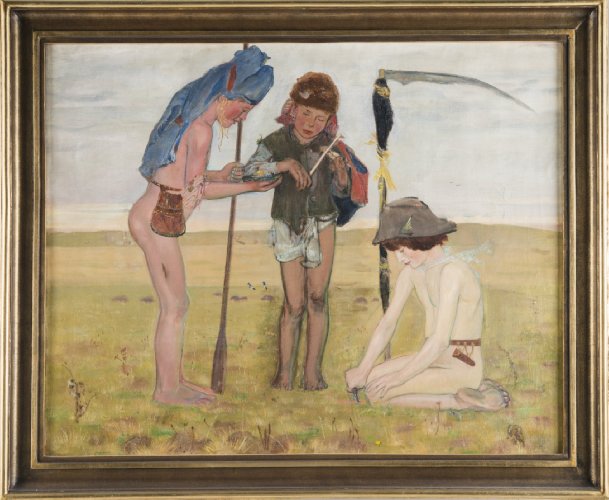Description:
Wlastimil Hofman (1881-1970) was born in Karlin, a suburb of Prague, Czech Republic, to a Czech father and a Polish mother. After moving to Krakow in 1889, his parents opened a shop with ornamental stones in the Sukiennice. From 1895, Hofman attended evening drawing classes at the School of Fine Arts in Florian Cynk’s studio. The following year he broke off his studies at the gymnasium and, at the age of 16, was accepted to the Krakow School of Fine Arts. At the third year of his studies he moved to Jacek Malczewski’s studio and participated in Jan Stanisławski’s outdoor classes. He graduated from the School as the top student with the opinion: “Hofman is an exceptionally talented individual, he develops quickly and independently”.* The same year he went to study in Paris, where he was a student of Leon Gérôme at the École des Beaux Arts. Due to financial difficulties, he was forced to return to Krakow. There he opened his first studio in Dębniki. In 1905, he founded the Group of Four with Mieczysław Jakimowicz, Leopold Gottlieb and Witold Wojtkiewicz, later transformed into the Group of Five (without Wojtkiewicz, with Jan Rembowski and Tymon Niesiołowski). They strove to revive the romantic idea of “correspondence of arts”, to revive the concept proclaimed by Baudelaire of the affinity of the visual arts, literature and music. They chose the great Polish romantic, poet, painter and draughtsman Cyprian Kamil Norwid as their patron. Hofman participated in all the exhibitions of the group, including in Vienna (1906, 1908) and Berlin (1907). After the outbreak of World War I he left with his father for Czechoslovakia. In the summer of 1917 he returned to Poland. After the critical reviews of his first post-war exhibition, he decided to go to Szklarska Poręba. He remained there until his death – the painter died in 1970, exactly two years after his beloved wife Adela Hammer. The poeticism, mood and expressiveness are the creative face of Wlastimil Hofman. These features sound even stronger when children take on the role of main characters. Their natural sensitivity becomes a pretext for reflections on the passing, in this case of a bird, which they bid farewell in a solemn way.
Description of the painting:
Against the backdrop of the wide-stretching fields of the spring landscape, a three-person group of boys is portrayed. Their semi-naked bodies are adorned with selected elements of clothing and props that complete the character of the presentation. The central place of the composition is occupied by the boy playing the violin, shown frontally. He is the only one from the whole group who is characterized by the fullest outfit. He wears a white shirt, a brown waistcoat and a furry cap from which a red-navy striped scarf encircles his rosy face. The costume is completed by the Krakow kaftan thrown over the left shoulder. Turned to the left, it is kept in the same colors as the scarf. The figure of the violinist is embraced by the boys portrayed in profile and turned to each other face-to-face. They are slightly bent to each other, occupied with the tasks assigned to them. The figure with pink complexion, standing on the left, holds a dead bird in his right hand. Looking at its yellow-blue plumage, we can assume that it is a sparrow. The boy looks at it with tenderness. His head is covered with a blue-red kaftan which freely falls on his back. The golden stems of grass stuck in his ears are arranged like locks of hair. His waist is tied with a belt with a leather pouch. In his left hand he holds an oar, turned feather-down to the ground. The whole is completed by the color scarf thrown over the right shoulder, in which, most likely, the little body of the bird will be wrapped. Opposite him, kneeling, is a figure distinguished by his pale body. With a knife taken out earlier from a sheath attached to the belt, the child is digging a hole between the tufts of grass. Thanks to the hat with wings, called a petasos, we recognize in him Hermes, the messenger of the gods. He came to escort the soul of the dead to the afterlife. The personification of death is the scythe here – a tool used to collect crops. Due to the renewed harvests dependent on the given cycle of nature, it is also a symbol of rebirth and resurrection. In combination with the oar which becomes a promise of further journey, it connotes positive associations – it brings closer to salvation.
The paintings of Wlastimila Hofman depict folk piety observed among the people who surrounded him. They take the form of theatrical stories, an interpretation of experiences and moments lived. The motif of transience appears in his work in many forms, although the main character – the bird and the accompanying children – reappears many times under various titles. By choosing the most fragile and innocent creatures, he sets them against death, showing it as an inseparable part of every person’s life.


